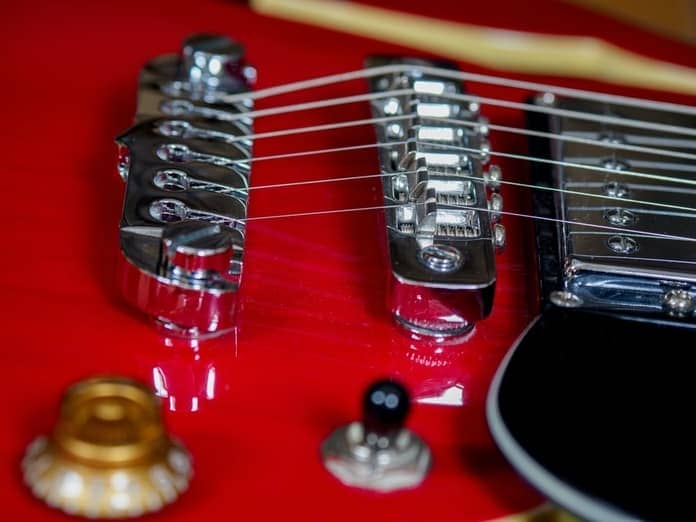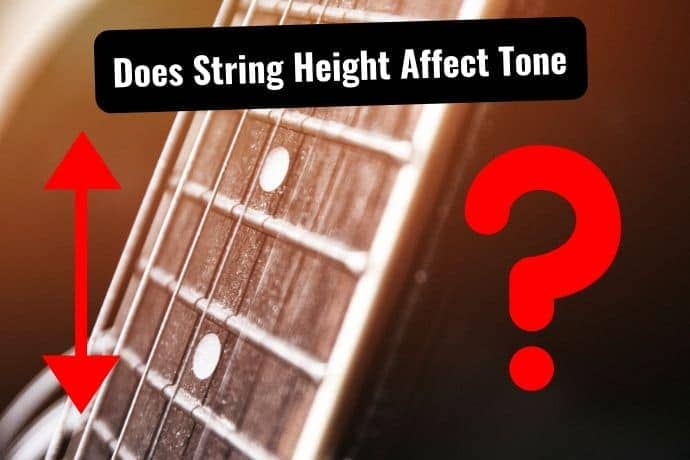So you’re wondering, can a professional setup on a cheap guitar really turbocharge its performance?
Can a budget mediocre guitar transform into a good guitar with a professional setup?

After owning many cheap guitars over the years, I decided to write this post to discuss this very topic.
This post will answer whether it’s worth getting a cheap guitar setup by a professional guitar tech. Let’s dive in…
It is definitely worth getting a cheap guitar setup by an experienced guitar tech. This will correct the guitar’s action, intonation, truss rodd, and saddle height, improving the guitar’s overall playability and tone. A Budget guitar can convert into a highly playable instrument with a correct setup.
How to Improve a Cheap Guitar’s Playability (Watch Below)
Why You Should Get a Cheap Guitar Setup
Getting a professional luthier to fine-tune your guitar to your needs will certainly increase the performance and playability of your guitar.
You can convert a cheap $150 guitar into a highly playable instrument with a good setup regardless if it’s a low entry guitar.
You should also know that whether your guitar is expensive, cheap, new or old, a setup will surely enhance and correct all the things necessary to make the guitar the most playable it can be.
Keep in mind, a budget guitar with a good setup can play better than an expensive guitar with a terrible setup. (Read that sentence a few times so it engrains into your brain.)
For example, if you have an expensive guitar that is not correctly intonated. No matter what you do, your notes will sound sharp or flat even when correctly tuned.
Secondly, your expensive guitar could have high-quality pickups, the richest wood, great construction, and a great tone.
However, if there are problems such as fret buzz, uncomfortable high action, and a bad nut, then your expensive guitar will play terribly degrading its performance.
For this reason, a guitar setup on either a budget or expensive guitar ensures it’s at optimal playability regardless of its value.
At the same time, having a cheap guitar that is properly well set up can provide all of the motivation needed to learn the instrument.
It is all of these reasons that lead me to assure you that you definitely should get your cheap guitar setup. The benefits you’ll get from it will justify the decision, trust me.
How To Know If Your Cheap Guitar Needs a Setup?
Several very specific factors can inform you of whether your guitar needs a setup or not.
Bad intonation, fret buzz, undesired string action, tuning issues, and the overall state of your hardware and electronics.
Here are some telltale signs your guitar may need a setup.
Fret Buzz
String action refers to how high or low your guitar’s strings are in relation to the fretboard.
The higher they are, the harder you have to fret down the strings (which might make it uncomfortable).
The lower the strings are, the more comfortable you’ll be but you might encounter some ‘buzzing’ while fretting the strings.
There is a sweet-spot where none of these two things occur and that is what you are looking for.
If you encounter fret buzz with your guitar’s truss rod and string height will need adjusting.
The Fretted Note is Out of Tune
Have you ever tuned your guitar perfectly then played a note, riff or chord and noticed it doesn’t sound right?
If the answer is yes, this is because the intonation is off.
Fortunately, there is a more accurate way of checking your guitar’s intonation.
This is done by playing the natural harmonic found on the 12th fret of a string and then playing the fretted note.
If the notes don’t match, then you need to adjust your intonation.
Your Guitar Won’t Stay In Tune
Annoying as this is, if your guitar will not stay in tune then there are possibly a few issues going on here. These issues can stem from either a;
- Worn or badly cut nut
- Tuning peg issues
- Saddle string height
- Bridge string contact
- Bad construction
A trained guitar tech can look over these issues and correct the problems that are affecting its tuning performance.
Unusual Noise and Interference
Finally, a check on the pickups and internal electronics may also be included.
Active pickups might also require a battery replacement and all nuts and screws should be properly tightened.
If you have any unwanted noise problems, this is also the moment to address those issues.
What Does A Guitar Setup Include?
Action – Adjust String Height
The action is known as the distance of the strings from the fretboard also known as string height.
High action requires more fretting pressure and better for strumming. In contrast, a low action is a short distance from the fretboard and is better for fast technical playing.
On the other hand, the action on your guitar will vary according to your needs. Some people like their action a bit higher than others, some like it very low.
This makes a crucial point as to why you should get a guitar setup. Every player has different needs, different expectations, and different touch.
Truss Rod Adjustment – Correct Relief
If you didn’t know already, a truss rod is a metal rod inside the neck including a truss rod to make fine adjustments.
Tightening or loosening the truss rod increases or decreases the tension.
Adding or removing the tension changes the curvature (bowing) of your neck. Bowing is also referred to as “relief.”
The function of the truss rod is to allow for the desired string height without the presence of any noticeable fret buzz.
The guitar tech will adjust the truss rod just so there’s a small amount of relief in accordance with the height of the strings without any fret buzz.
Hardware Check
Another overlooked aspect is an inspection of the hardware. This includes tightening loose parts such as jack, tuners, and loose knobs.
This ensures all the hardware is maintained and in good shape.
Deep Clean – A Clean Guitar Is a Faster Guitar
No guitar setup is complete without a good spring clean removing any dirt, grease, and nasty muck from your prized instrument.
The fretboard is usually the worst area so will definitely need a deep clean to remove dirt and grime.
Likewise, the full guitar will receive a good polish and maybe some finish protector as a nice bonus.
New Strings
Once all the tinkering is complete, have your favorite strings installed. It is standard to apply new strings to a guitar that has undergone a full setup.
Intonation – Ensures your Guitar is in Pitch
The last step in setup is adjusting the intonation. A guitar intonated accurately means all the open strings are tuned to the correct pitch.
If the open strings are not in the right pitch in accordance with the fretted notes, then your guitar will sound slightly flat or sharp. Basically not in tune!
The intonation is adjusted by rotating the screws on the bridge which moves the saddles forward or backward.
By getting your cheap guitar setup you can have a professional tailor to your particular touch and make your guitar much more enjoyable.
Should You Set Up Your Own Guitar?
In reality, learning the basics of setting up your guitar is not a super complex process.
It is a skill that can be learned fairly quickly, with the right tutoring and practice.
The great thing about it too is that by doing so you can have a more precise set up according to your needs. You can also save yourself some money, which is always a plus.
How To Do A Complete Guitar Setup (Watch Below)
There is a potential risk you hold by setting up your guitar without properly understanding how to do it.
You can do some damage to your guitar that may not be permanent but will provide some amount of stress to you.
I would not recommend attempting a setup on an expensive guitar if it is your first time (leave it to an experienced tech.)
However, you should attempt one on an inexpensive guitar you feel comfortable practicing on.
Having said this, I would recommend you find a trained luthier or experienced friend who is willing to show you the proper way of doing it. Watch his process and ask any questions you have.
There are a ton of guitar setup tutorials on YouTube giving you the knowledge of how to correctly adjust and maintain your guitar whether it’s an electric, acoustic or bass.
This is how I learned to set up my prized guitars saving me a ton of money in the process.
You can then practice little details with your guitar until you are comfortable enough to do a full setup.
I am a big advocate of doing your own setups as it gives you great amounts of knowledge in terms of how guitars work.
This can also give you a better understanding of your own guitar since all guitars are slightly different.
How Often Should I Get A Guitar Setup?
There are some factors you must consider before answering this question.
Fender Support recommends a full setup approximately every six months. Generally speaking, this is a good amount of time between setups and some people even go as far as once a year.
Again, it really depends on how often you play and how comfortable or not you are with your guitar.
The weather conditions of where you live and how humid or dry it is will affect the regularity of your setups. It also depends on whether you are comfortable with your current setup or not.
I personally support a 6-month checkup, particularly before summer and winter since it’s when the temperature is most different.
It is also an optimal time to keep an eye on elements such as fret wear and the overall state of your hardware.
If you have just purchased a new guitar, I would suggest testing it’s set up straight out the box to uncover any issues that may need adjusting.
Keep in mind, not all guitars are given a solid setup before being shipped off which I will discuss in just a second.
Taking proper care of your guitar after practice sessions will also help extend your guitar’s “life”.
Do New Guitars Come Setup?
Well yes, and no. While guitars do come with a manufacturers’ setup, many guitars may still need some additional work.
This is mainly due to the fact that every player has different expectations and needs to feel comfortable playing their new guitar. There is not an ideal setup that applies to every guitar player out there.
There are some cases where this doesn’t hold to be true. Custom made guitars usually involve contact with the luthier to fine-tune performance and playability details.
However, cheap guitars will not have such a personal process and will most likely need a setup.
This is typical of budget guitars less than $200 manufactured in the far East which are not set up correctly before they leave the factory, this is obviously to save costs.
You also have to consider that even if a cheap guitar has a pretty good setup, it might have been sitting for a while before you purchased it.
Factors such as temperature and humidity will naturally affect some of the setups it initially had when it is being shipped to your door or the guitar store.
Unless you feel extremely comfortable with your guitar from the start, I’d suggest you have an initial setup right off the bat. This will allow you to have a better feel for your guitar.
It will also ensure you have the best guitar possible so you can afterward enjoy the hell out of it.
Final Thoughts
As you can see, the benefits of getting your cheap guitar setup are many. From understanding your guitar better to getting a guitar with enhanced playability, you can only profit from a professional setup. You can also take this opportunity to ask your luthier on potential upgrades that can improve your guitar.
Check Out My Related Post

Guitar players have noticed differences in sound when adjusting guitar action.
To understand and learn the differences check out my next post “Does Guitar String Height Affect Tone?”
